Now through April 9 at the Legion of Honor in San Francisco –– Auguste Rodin: The Centenary Installation. The exhibit commemorates the hundredth anniversary of the sculptor’s death with a fresh installation of over fifty works selected from the Legion’s extensive Rodin collection. The saga of the acquisitions begins with the founder of the Legion of Honor, Alma de Bretteville Spreckels and her acquaintance with Loïe Fuller – an unconventional celebrity from the American dance scene who became an aggressive broker for the artist. Loïe arranged Alma’s first meeting with Rodin in Paris, 1914. By the following year, Mr. and Mrs. Adolph Spreckels were viewing the beginnings of their collection in the Court of Honor at San Francisco’s Pan Pacific International Exposition. “This is something I’ve been wanting to do since I came here in 2004,” said curator Martin Chapman.
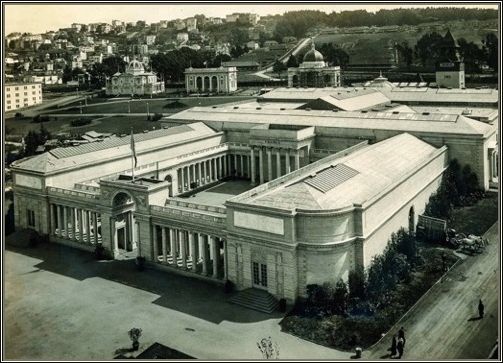
The French Pavilion, 1915 Pan Pacific International Exposition
“The idea of this display is that it’s more connected chronologically. You can see the development of the artist’s work – from the early days to the great achievements after 1900. Within that are different themes and different projects – such as The Burghers of Calais, the portraits, the late marbles, his unfinished masterpiece – The Gates of Hell. There are so many things that curators do, exhibitions being Number One.”

The Age of Bronze, 1877 (cast ca. 1914). Bronze, 71 1/2 x 21 1/4 x 25 1/2 in. Gift of Alma de Bretteville Spreckels, 1940.
My first experience of the Legion of Honor is linked to a school field trip. It was preparation season for First Communion. A few yards past the museum entrance and I am bowled over by The Age of Bronze and totally attentive to St. John the Baptist Preaching. So easy to remember / always a pleasure to see. They’ve been here over a hundred years. A very smart move. The event designers reworked the guys’ lighting schemes and fashioned new pedestals topped with Corian.
“It has a very clean look to it,” said Martin. “There are weight boxes inside which are meant to counter the effects of gravity. It’s important that the Rodin exhibit look as good as possible. It is the core of the Legion’s collection.”
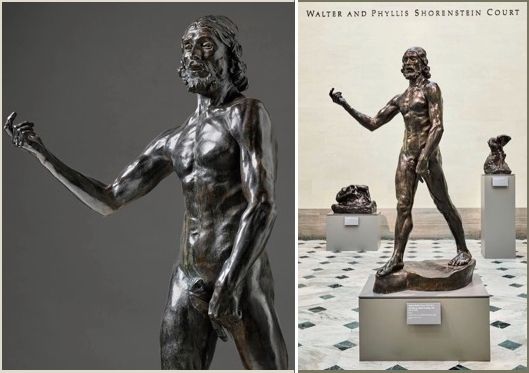
St. John the Baptist Preaching 1880 (cast ca. 1914). Bronze, 79 1/2 x 51 5/8 x 38 5/8 in. Gift of Alma de Bretteville Spreckels, 1940.
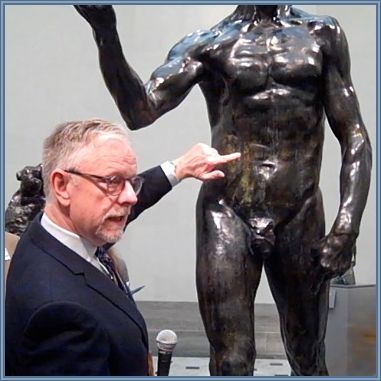
MARTIN CHAPMAN
“Every time I look, I find something different – whether it’s in the expression, the modeling or the patination. Some of the sculptures are very, very difficult to understand. And very complex – writhing figures, trying to determine which limb belongs to which character. What is Rodin trying to say?”
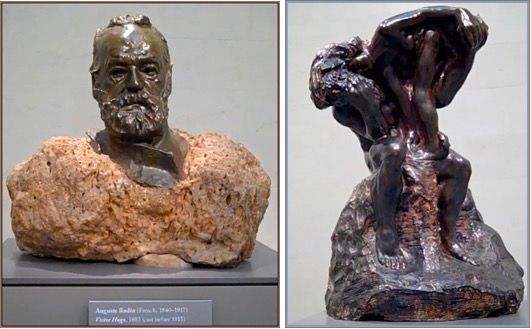
Victor Hugo, 1883 (cast before 1915). Bronze with marble base, 15 7/8 x 10 3/8 x 9 3/8 in. Gift of Alma de Bretteville Spreckels, 1941. The Sculptor and His Muse, 1890s (cast ca. 1908-1917). Bronze, 26 × 18 7/8 × 19 7/8 in. Gift of Alma de Bretteville Spreckels, 1941.
“Some are quite static by comparison. But movement is an aspect that is amazing in his models. It’s the universality, that ability he had to cover so many aspects – physical attributes, strange and unusual poses, dance movements, emotions that are sometimes very raw. None of this was covered under the tradition of academic sculpture. That is why Rodin is groundbreaking.”
I asked Martin if he thinks the poetic warning, “Abandon all hope, ye who enter here” continues to resonate around the idea of an entryway to Hell. Even though Rodin’s ultimate masterpiece was left unfinished, does the work itself remain as spiritually disquieting as it might have been in the sculptor’s lifetime?
“I’m sure. It doesn’t have that motto, but that was the original intention. The figures of the Three Shades pointing downwards are intended to point to that motto, but Rodin did not include it. He changed his ideas many, many times over this project. It took twenty years to get to the point of exhibiting it. The Gates of Hell still has this sense of turmoil, chaos and torment. This is not a happy piece of sculpture. It is something that tells us about the fate of man.”
To frighten the hell out of us?

The Three Shades, 1898 (enlarged 1902-04, cast ca. 1923. Bronze, 75 1/2 x 73 1/2 x 41 1/2 in. Gift of the Raphael Weill Memorial Committee
“Literally. Rodin modeled 220 figures for it. It’s interesting that he effectively abandoned it, that he stopped after 1900. There is a model in the studio where the figures have all been removed. That was what he showed to the public in 1900 – as if he’d become disenchanted with it.”
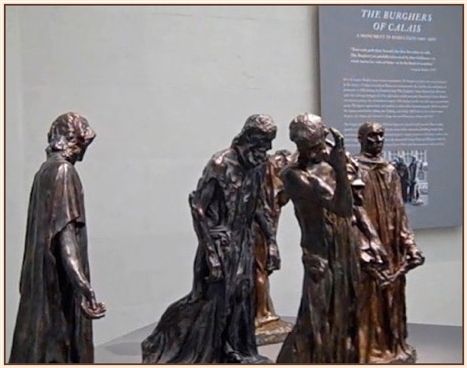
The Burghers of Calais, 1886-88. Bronze, various dimensions. Fine Arts Museums of San Francisco, Gift of Alma de Bretteville Spreckels, 1941.
For me, the major takeaway of the exhibit is the dramatic intensity of The Burghers of Calais. The Legion’s collection consists of five reductions of the original six larger-than-lifesize figures commissioned by the city of Calais in 1884 and finished in 1889. The characters come from a chapter out of the (longer than) Hundred Years’ War (1337-1453). The story centers around the siege of Calais, a port town located in northern France on the English Channel, which Edward III held captive for nearly a year, driving its citizens to starvation. Edward’s terms for the city’s surrender included that a number of its citizens be executed. Six men stepped forward. Rodin creates the moment before the volunteers learn their lives will be spared.
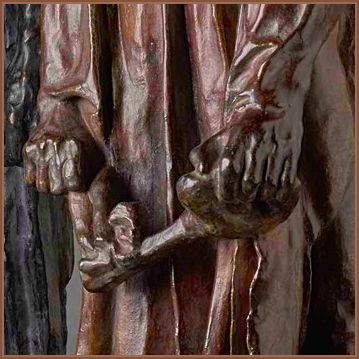
Jean D’Aire – holding the keys of Calais
“The Burghers are expecting to be killed. That is what Rodin is portraying – the expectation of their own end. The fact they were let off is beyond the scope of what these sculptures are meant to tell us. What they are each showing is agony, the anguish of facing their end. It is expressed through the modeling of the figures. For example, the enormous size of the hands of Jean d’Aire. He is holding the keys to the city. He must hand them over to the English. That is the important aspect – the way the bodies express anguish, the tremendous weight of the burden they have to face. We are lucky to also have the plaster reduction of the head of Pierre de Wiessant.”
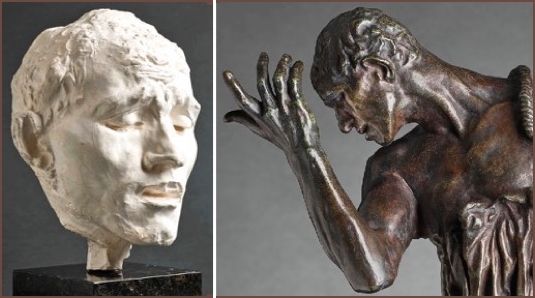
Head of Pierre de Wiessant, ca. 1886. Plaster, 11 3/8 x 8 5/8 x 9 5/8 in. Gift of Adolph B. Spreckels, Jr., 1933. Pierre de Wiessant, 1886 (reduced 1886, cast before 1929). Bronze, 17 3/4 x 9 x 9 in. (45.1 x 22.7 x 22.7 cm). Inscribed: A. Rodin and ALEXIS. RUDIER. / FONDEUR. PARIS. Fine Arts Museums of San Francisco, Gift of Alma de Bretteville Spreckels, 1941
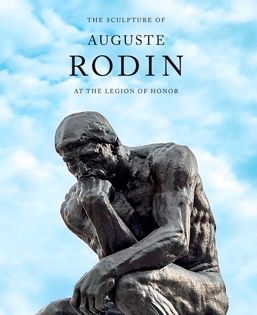
Martin Chapman is curator in charge of European Decorative Arts and Sculpture for the Fine Arts Museums of San Francisco [FAMSF]. His companion volume for the event, The Sculpture of Auguste Rodin at the Legion of Honor, includes the exhibit items which have been beautifully captured by photographer Randy Dodson, along with Martin’s vibrant and arresting perspectives on the sculptor, the times, and the extraordinary cast of characters who secured the works for San Francisco. Martin expressed his appreciation for the Legion’s 1977 catalogue assembled by Jacques de Caso and Patricia Sanders.
“I’m very fortunate to have a fabulous collection to work with and at last we’ve got a book that really does chronicle much of it. It’s not a fully fledged catalogue like the 1977 publication. It is not a catalogue raisonné. It is a book about the collection. It was a question of trying to narrow down all the information rather than to add, because there is so much information on him. He became such a superstar from 1900 onwards that there were people sitting at his feet – such as the poet Rilke who was writing down every word. So, we know a lot – certainly from the latter part of his career. They were all documenting what he said. I think Rodin rather enjoyed that.”